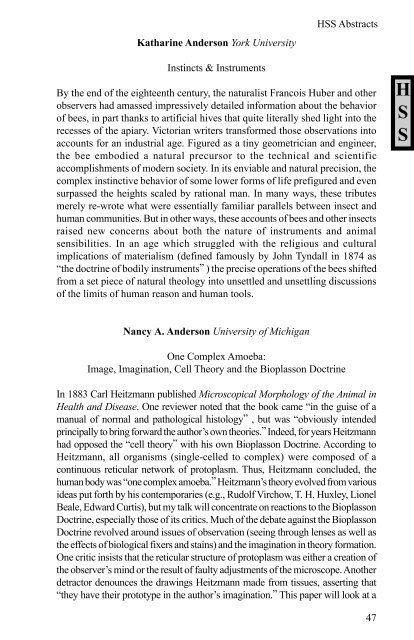2000 HSS/PSA Program 1 - History of Science Society
2000 HSS/PSA Program 1 - History of Science Society
2000 HSS/PSA Program 1 - History of Science Society
Create successful ePaper yourself
Turn your PDF publications into a flip-book with our unique Google optimized e-Paper software.
Katharine Anderson York University<br />
<strong>HSS</strong> Abstracts<br />
Instincts & Instruments<br />
By the end <strong>of</strong> the eighteenth century, the naturalist Francois Huber and other<br />
observers had amassed impressively detailed information about the behavior<br />
<strong>of</strong> bees, in part thanks to artificial hives that quite literally shed light into the<br />
recesses <strong>of</strong> the apiary. Victorian writers transformed those observations into<br />
accounts for an industrial age. Figured as a tiny geometrician and engineer,<br />
the bee embodied a natural precursor to the technical and scientific<br />
accomplishments <strong>of</strong> modern society. In its enviable and natural precision, the<br />
complex instinctive behavior <strong>of</strong> some lower forms <strong>of</strong> life prefigured and even<br />
surpassed the heights scaled by rational man. In many ways, these tributes<br />
merely re-wrote what were essentially familiar parallels between insect and<br />
human communities. But in other ways, these accounts <strong>of</strong> bees and other insects<br />
raised new concerns about both the nature <strong>of</strong> instruments and animal<br />
sensibilities. In an age which struggled with the religious and cultural<br />
implications <strong>of</strong> materialism (defined famously by John Tyndall in 1874 as<br />
“the doctrine <strong>of</strong> bodily instruments” ) the precise operations <strong>of</strong> the bees shifted<br />
from a set piece <strong>of</strong> natural theology into unsettled and unsettling discussions<br />
<strong>of</strong> the limits <strong>of</strong> human reason and human tools.<br />
H<br />
S<br />
S<br />
Nancy␣ A. Anderson University <strong>of</strong> Michigan<br />
One Complex Amoeba:<br />
Image, Imagination, Cell Theory and the Bioplasson Doctrine<br />
In 1883 Carl Heitzmann published Microscopical Morphology <strong>of</strong> the Animal in<br />
Health and Disease. One reviewer noted that the book came “in the guise <strong>of</strong> a<br />
manual <strong>of</strong> normal and pathological histology” , but was “obviously intended<br />
principally to bring forward the author’s own theories.” Indeed, for years Heitzmann<br />
had opposed the “cell theory” with his own Bioplasson Doctrine. According to<br />
Heitzmann, all organisms (single-celled to complex) were composed <strong>of</strong> a<br />
continuous reticular network <strong>of</strong> protoplasm. Thus, Heitzmann concluded, the<br />
human body was “one complex amoeba.” Heitzmann’s theory evolved from various<br />
ideas put forth by his contemporaries (e.g., Rudolf Virchow, T. H. Huxley, Lionel<br />
Beale, Edward Curtis), but my talk will concentrate on reactions to the Bioplasson<br />
Doctrine, especially those <strong>of</strong> its critics. Much <strong>of</strong> the debate against the Bioplasson<br />
Doctrine revolved around issues <strong>of</strong> observation (seeing through lenses as well as<br />
the effects <strong>of</strong> biological fixers and stains) and the imagination in theory formation.<br />
One critic insists that the reticular structure <strong>of</strong> protoplasm was either a creation <strong>of</strong><br />
the observer’s mind or the result <strong>of</strong> faulty adjustments <strong>of</strong> the microscope. Another<br />
detractor denounces the drawings Heitzmann made from tissues, asserting that<br />
“they have their prototype in the author’s imagination.” This paper will look at a<br />
47
















